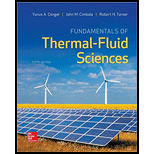
Concept explainers
(a)
The amount of ice that needs to be added into water at 0 C of temperature.
(a)
Explanation of Solution
Given:
The density of the water
The volume of the water
The initial temperature of water
The initial temperature of ice
The final temperature of ice
The mass of the water
The heat of fusion of ice
Calculation:
Calculate the mass of the water.
Refer the Table A-3 “Properties of common liquids, solids and foods”,
The value of specific heat of ice at 0 C
Write the expression for the energy balance equation.
Here, the total energy entering the system is
Simplify Equation (II) and write energy balance relation of cold water.
Here, the heat to be transfer into the system is
Substitute 0 for
Thus, the amount of ice that needs to be added into water at 0 C of temperature is
(b)
The amount of ice that needs to be added into water at -20 C of temperature and the amount of water that needs to cool down the cold water at 0 C of temperature.
(b)
Explanation of Solution
Substitute 0 for
For initial temperature of ice as -20 C instead of 0 C.
Substitute
Thus, the amount of ice that needs to be added into water at -20 C of temperature is
Substitute
Thus, the amount of water that needs to cool down the cold water at 0 C of temperature is
Want to see more full solutions like this?
Chapter 5 Solutions
Fundamentals of Thermal-Fluid Sciences
 Elements Of ElectromagneticsMechanical EngineeringISBN:9780190698614Author:Sadiku, Matthew N. O.Publisher:Oxford University Press
Elements Of ElectromagneticsMechanical EngineeringISBN:9780190698614Author:Sadiku, Matthew N. O.Publisher:Oxford University Press Mechanics of Materials (10th Edition)Mechanical EngineeringISBN:9780134319650Author:Russell C. HibbelerPublisher:PEARSON
Mechanics of Materials (10th Edition)Mechanical EngineeringISBN:9780134319650Author:Russell C. HibbelerPublisher:PEARSON Thermodynamics: An Engineering ApproachMechanical EngineeringISBN:9781259822674Author:Yunus A. Cengel Dr., Michael A. BolesPublisher:McGraw-Hill Education
Thermodynamics: An Engineering ApproachMechanical EngineeringISBN:9781259822674Author:Yunus A. Cengel Dr., Michael A. BolesPublisher:McGraw-Hill Education Control Systems EngineeringMechanical EngineeringISBN:9781118170519Author:Norman S. NisePublisher:WILEY
Control Systems EngineeringMechanical EngineeringISBN:9781118170519Author:Norman S. NisePublisher:WILEY Mechanics of Materials (MindTap Course List)Mechanical EngineeringISBN:9781337093347Author:Barry J. Goodno, James M. GerePublisher:Cengage Learning
Mechanics of Materials (MindTap Course List)Mechanical EngineeringISBN:9781337093347Author:Barry J. Goodno, James M. GerePublisher:Cengage Learning Engineering Mechanics: StaticsMechanical EngineeringISBN:9781118807330Author:James L. Meriam, L. G. Kraige, J. N. BoltonPublisher:WILEY
Engineering Mechanics: StaticsMechanical EngineeringISBN:9781118807330Author:James L. Meriam, L. G. Kraige, J. N. BoltonPublisher:WILEY





